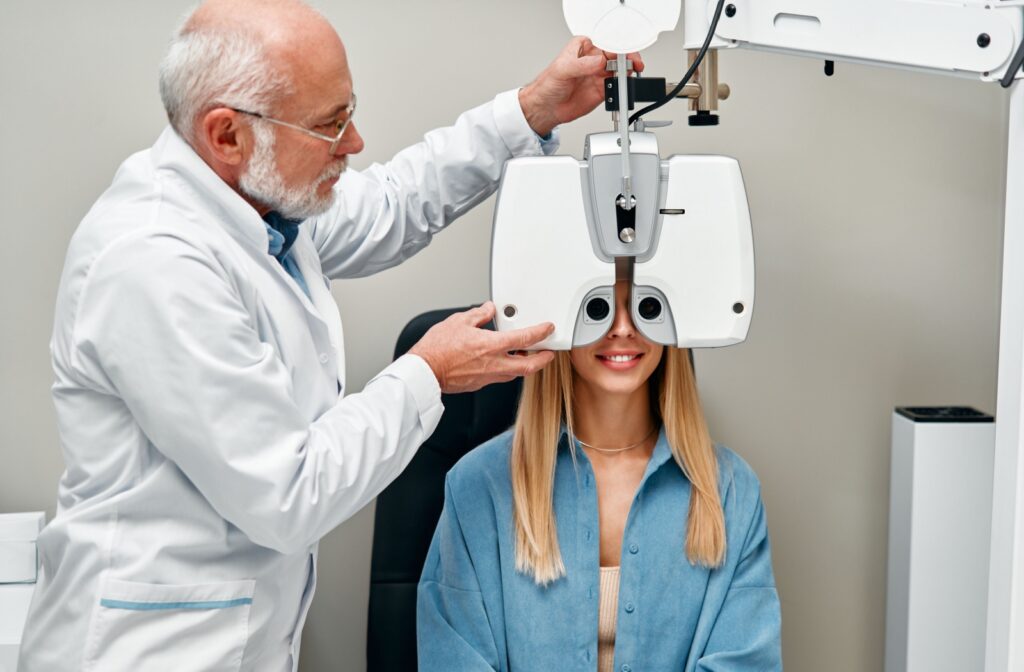Is the world starting to look a little… off? You blink. Rub your eyes. Blink again. Still blurry.
If everything seems a little fuzzy around the edges, even after you’ve cut back on screen time and gotten some sleep, there’s a good chance it’s more than just tired eyes. You could have astigmatism.
Astigmatism is a refractive error that interferes with how your eye bends light and can cause blurry vision. It happens when your eye can’t focus light evenly onto the retina, leading to fuzzy or distorted images.
What Is Astigmatism?
Astigmatism is one of those eye conditions that sounds more serious than it usually is. In short, it’s a common refractive error, aka your eye’s way of bending light just a little… wrong.
Instead of focusing light neatly on the retina (the part of your eye that helps you actually see), astigmatism sends light off in different directions. The result? Blurry or distorted vision at pretty much any distance.
Imagine trying to watch a movie with a projector that’s a little out of focus, no matter how close or far you sit, things never look quite right.
Astigmatism is common and can occur on its own or alongside nearsightedness (myopia) or farsightedness (hyperopia).
What Causes Astigmatism & What Are the Symptoms?
Astigmatism can be present from birth or develop over time. It may also result from an eye injury, disease, or surgery. In some cases, a specific condition called keratoconus can cause a progressive thinning of the cornea, leading to more severe astigmatism.
While many people have some degree of astigmatism without noticeable issues, more significant cases can cause a variety of symptoms, including:
- Blurry or distorted vision
- Eyestrain
- Headaches
- Difficulty seeing clearly at night
- Squinting
- Trouble seeing both near and far objects
These symptoms may come on gradually, making them easy to ignore even if you’ve never needed glasses before. But if you find yourself squinting to read your phone or struggling to focus during work, it could be a sign your eyes aren’t seeing as clearly as they could.
Types of Astigmatism
Not all astigmatism is the same. There are different types, depending on where the irregular curvature occurs and how it affects your vision.
- Corneal astigmatism: Caused by an irregularly shaped cornea. This is the most common type and affects how light enters the eye.
- Lenticular astigmatism: Caused by an irregularly shaped lens inside the eye. This type can occur even if the cornea is normal.
Astigmatism can also be classified as:
- Regular astigmatism: The most common form, where the curvature is uneven but symmetrical. It can usually be corrected with glasses or contact lenses.
- Irregular astigmatism: Less common, often caused by injury or conditions like keratoconus. It may require specialized lenses or other treatments.
Understanding the type of astigmatism you have can help determine how to correct it.

How Eye Doctors Identify Astigmatism
Astigmatism is typically diagnosed during a comprehensive eye exam. Your eye doctor will perform a series of tests to evaluate how your eyes focus light. These may include:
- Visual acuity test: Reading letters on a chart to assess sharpness of vision.
- Keratometry: Measuring the curve of your cornea.
- Refraction: Determining the right lens prescription to correct your vision.
These tests help your optometrist determine the type and degree of astigmatism, and whether you’ll benefit from corrective lenses or other treatment options.
How Astigmatism Is Treated
Most cases of astigmatism can be corrected with prescription glasses or contact lenses. These lenses are designed to compensate for the uneven curvature in your cornea or lens, allowing light to focus properly on the retina. Some people may benefit from toric contact lenses, which are specifically shaped to address astigmatism.
For people with more severe or irregular astigmatism, rigid gas-permeable or scleral contact lenses may be recommended. In select cases, refractive surgery such as LASIK may also be an option, though this depends on your overall eye health and the type of astigmatism present.
When Should You Get Your Eyes Checked?
Astigmatism often worsens gradually, so early detection is key. Even small changes in your vision can impact your ability to drive safely, work effectively, or enjoy your day-to-day life.
Regular eye exams are important if:
- You’ve never had one before
- You’ve noticed changes in your vision
- You’re overdue for your annual exam
Your optometrist can provide clarity and offer solutions like glasses, contact lenses, or referrals for other treatments.
Bringing Life Back into Focus
Yes, astigmatism can cause blurry vision, but it’s manageable with the right care. The team at Total Vision San Clemente is committed to helping you see clearly in a comfortable, welcoming environment. We provide personalized care and a forward-thinking approach to help you protect your vision and feel confident in your eye health.
If your vision is feeling off, don’t ignore it. Book an eye exam today and get back to seeing the world with clarity.




